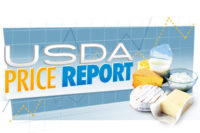Dairy Market News
Where's the butter? Some inventories are close to zero. USDA also reports that extra milk for cheese is scarce
Cream demand is steady to higher into ice cream, whipping cream, cream cheese.

The following summary is from the USDA's Dairy Market News for the week of April 15 to 19. Download the complete 25-page Dairy Market News report.
 BUTTER HIGHLIGHTS: Class II cream demand is diverting increasing cream volumes away from butter churning operations across the country. Churning is still active, and different Q1 marketing strategies have manufacturers’ inventories varying widely. Some butter manufacturers find their inventories are close to zero because they employed aggressive make and sell marketing strategies. Other manufacturers followed make and hold tactics, and currently have substantial butter inventories. One strategy may provide challenges for meeting mid to late summer butter commitments, while the other may lead to near to mid-term asset value risk, according to market participants. Price increases Monday through Thursday, built upon sales and unfilled bids at the CME, garnered a weekly total gain of 4.75 cents.
BUTTER HIGHLIGHTS: Class II cream demand is diverting increasing cream volumes away from butter churning operations across the country. Churning is still active, and different Q1 marketing strategies have manufacturers’ inventories varying widely. Some butter manufacturers find their inventories are close to zero because they employed aggressive make and sell marketing strategies. Other manufacturers followed make and hold tactics, and currently have substantial butter inventories. One strategy may provide challenges for meeting mid to late summer butter commitments, while the other may lead to near to mid-term asset value risk, according to market participants. Price increases Monday through Thursday, built upon sales and unfilled bids at the CME, garnered a weekly total gain of 4.75 cents.
CHEESE HIGHLIGHTS: Good volumes of milk available to cheese plants are keeping production in the West seasonally heavy and in the East, on 6-7 day production schedules. Midwestern cheese manufacturers had all of the milk they wanted for cheese making last week, some at below Class III prices. That has changed. This week, extra milk is harder to obtain. Some manufacturers looking for extra milk could not obtain any. Midwestern manufacturers perceive that there is an “adequate” domestic supply of cheese. A noticeable increase in activity from foreign buyers has now resulted in what one Midwestern cheese manufacturer calls “a seller’s market” for export transactions. Western cheese buyers are being a little more aggressive in taking ownership. Most indicate that they are comfortable with current inventory levels. Blocks are definitely finding more buyer interest than barrels. Some contacts note that yields are beginning to back off seasonally.
FLUID MILK: Farm milk production is in varying stages of moving through the flush across the nation. Southern tier states note the peak is over and milk intakes are receding slightly. Southwestern milk is seeing week to week gains along the coast, but Arizona milk is decreasing after cresting recently. North Central farm milk intakes are mostly steady compared to last week as cold, wet weather covers that portion of the country. Milk handlers in the Northeast and Mid-Atlantic report intakes are increasing steadily. Delivered prices into the Central region reportedly topped $300/ ton this week. Cream demand is steady to higher into ice cream, whipping cream, cream cheese.
Looking for a reprint of this article?
From high-res PDFs to custom plaques, order your copy today!






